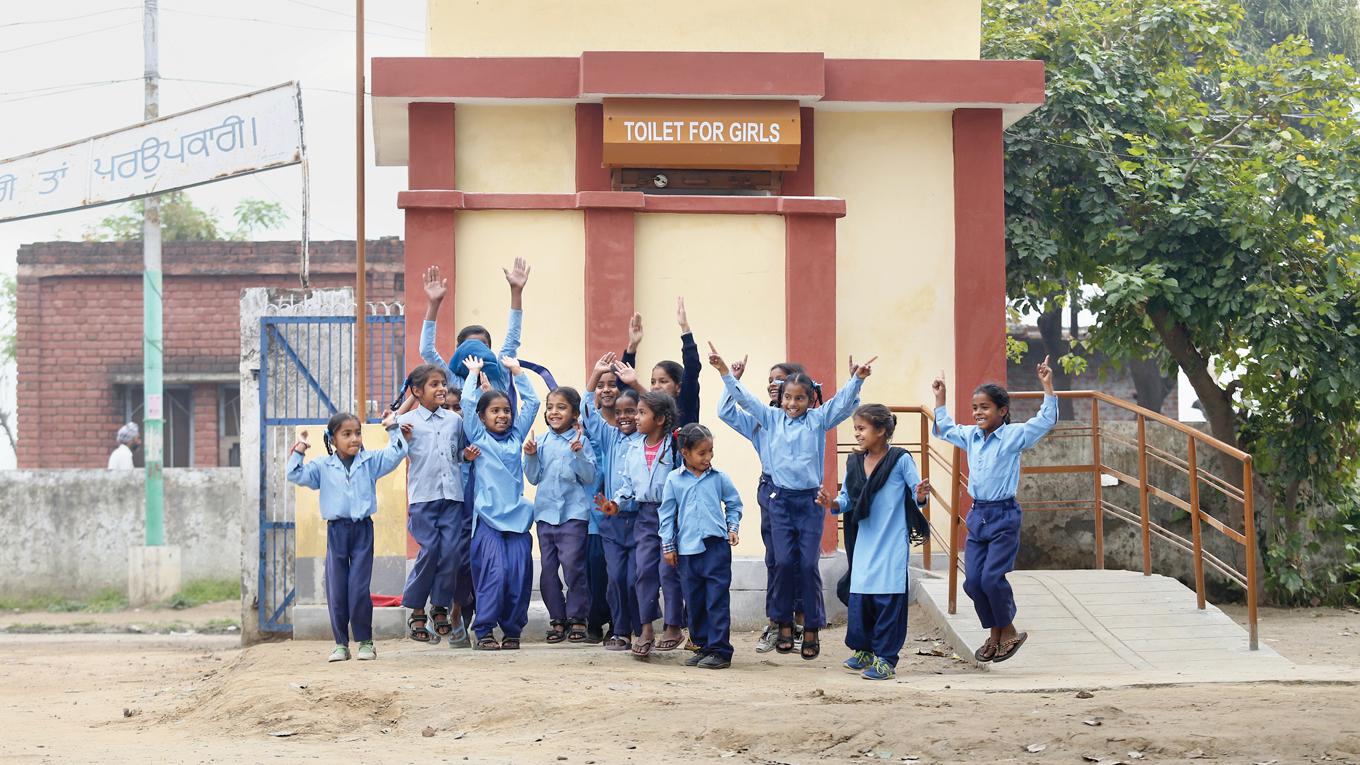-

Satya Bharti Abhiyan: channelising students’ enthusiasm
nspired by the call to the corporate sector by the prime minister, Satya Bharti Abhiyan was launched by telecom major Bharti in August 2014 with an allocation of Rs100 crore to improve sanitation conditions in large geographic areas, by providing access to toilets to all households and fostering behaviour change through information education and communication (IEC). The implementation was done in collaboration with all stakeholders, – the government, the communities, gram panchayats, the beneficiaries and the students of Satya Bharti schools. This comprehensive implementation through well-designed processes complemented the government’s efforts and empowered all stakeholders. Till February 2019, the company had built 18,400 toilets in Ludhiana and over 5,000 in rural Amritsar. The project covered 792 villages in rural Ludhiana, 118 villages in rural Amritsar, and 11 urban local bodies in urban Ludhiana with a total of over 119,000 beneficiaries. Sanitation awareness The funds for the Abhiyan are provided by Bharti group companies and construction of toilets and communication rollouts are deployed by partners. The implementation of Satya Bharti Abhiyan starts with informing the community about the programme and encouraging them to participate. A village meeting is organised to share information about the programme and to invite applications from households requiring a toilet. Announcements are also made at public places to inform the community about the scheme. The field team engages with direct beneficiaries and with community members to increase awareness on the importance of healthy sanitation practices. A well-structured communication campaign comprises of one-on-one interactions with villagers, display of posters, distribution of booklets, and meetings and road marches across the village. Women were encouraged to participate in communication activities and in the monitoring of construction of their own toilets. The construction partners appointed women as “motivators” to carry out one-on-one interactions with beneficiaries and also to check usage.
-
While the project was rolled out in Punjab, the impact of the programme was felt in all states where Satya Bharti Schools are present
While the project was rolled out in Punjab, the impact of the programme was felt in all states where Satya Bharti Schools are present including Rajasthan, Haryana, West Bengal, Tamil Nadu and Uttar Pradesh because campaigns were run by students and teachers of the 254 Satya Bharti schools, resulting in the construction of over 3,000 toilets in the homes of students. Random sample checking of usage after one year of handing over of toilets through teams deployed in the field helped in identifying the reasons and gaps in usage and maintenance enabling targeted IEC.
In the case of girls’ toilets to be constructed in government schools, the list of schools was obtained from the state education department. The sarpanch was involved in the release of payment for the construction of toilets. In Ludhiana, the Foundation forwarded the list of all beneficiaries to the Deputy Commissioner’s office and the Nodal Officer, Swachh Bharat Mission, to upload the same on the government’s Swachh Bharat Mission website. This step ensured an independent check of the number and quality of toilets constructed, also bringing in transparency across all stakeholders.
Provision of toilets to households enabled rural Ludhiana district to achieve ‘Open Defecation Free’ (ODF) status in November 2016. Thereafter toilets were provided in urban Ludhiana, where the work was completed in June 2018. In addition, 14 Government schools, identified by Punjab Education Development Board, were provided with separate toilets for girls in rural Ludhiana. In July 2017, the Foundation expanded programme outreach by launching the project in Amritsar to support the construction of 20,000 toilets in rural Amritsar. A sample survey on the usage of toilets revealed that most people are aware of the proper usage, operation and maintenance of toilets.
The success and sustainability of Satya Bharti Abhiyan largely lay on the sense of ownership of beneficiaries and stakeholders. The toilet provided is easy to maintain and requires local materials and local tradesmen to repair it. Delivery of good quality toilets reduces the requirement of maintenance and thereby, the need of funds required to maintain them.
The beneficiary households are educated on the operation (the process of usage and cleaning) and basic maintenance of the toilet (e.g. minor repair of cracks, painting, prevention from rust/seepage and navigation between pits). Instruction manuals and booklets which can be referred to in the future are provided to all households as part of the IEC. Toilet maintenance can also be done along with other household infrastructure maintenance by the beneficiary herself/himself, thereby reducing the cost further.
To effectively implement the project, structured capacity-building of the construction partners and the tradesmen were organised by the Foundation at regular intervals. These partners and tradesmen continue to work in the sanitation sector beyond the time and the geographic boundary of the Abhiyan – thereby benefitting other communities and impacting sustainability.
Because the Abhiyan team worked in close co-ordination with DWSS, Swachh Bharat Mission officials and the office of the Deputy Commissioner, there were shared learning and leveraging of each other’s strengths and efforts, and a force multiplier effect. Inclusion of toilets provided into the government’s database enabled these to be considered for future schemes – of monitoring, communication or improvement. The beneficiaries of the Abhiyan get the advantages of community groups formed under the Swachh Bharat Mission for ensuring usage and maintenance of toilets. A study conducted by WSP-ESI8 reveals that by investing in comprehensive sanitation, India can potentially gain Rs1,321 per capita. Applying this calculation Bharti analyzed that the construction of ~18,000 toilets in Ludhiana impacting approximately 90,000 users, would lead to a gain of over Rs11 crore.
Biogas
BioEnergy will showcase its innovative biogas technology in India
Mobility
Ather aims to produce 20,000 units every month, soon
Green Hydrogen
German Development Agency, GIZ is working on a roadmap for a green hydrogen cluster in Kochi
Renewable Energy
AGEL set to play a big role in India’s carbon neutrality target



















